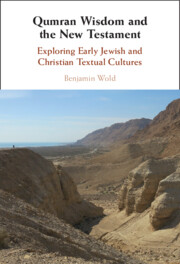Book contents
- Qumran Wisdom and the New Testament
- Qumran Wisdom and the New Testament
- Copyright page
- Dedication
- Contents
- Preface
- Acknowledgments
- Introduction
- 1 Cosmology and Eschatology
- 2 Universalism and Particularism
- 3 Wisdom As Action
- 4 Poverty and Humility
- 5 Debt Remission in the Matthean Lord’s Prayer
- 6 Paul
- Conclusion
- Bibliography
- Index
5 - Debt Remission in the Matthean Lord’s Prayer
Published online by Cambridge University Press: 22 December 2022
- Qumran Wisdom and the New Testament
- Qumran Wisdom and the New Testament
- Copyright page
- Dedication
- Contents
- Preface
- Acknowledgments
- Introduction
- 1 Cosmology and Eschatology
- 2 Universalism and Particularism
- 3 Wisdom As Action
- 4 Poverty and Humility
- 5 Debt Remission in the Matthean Lord’s Prayer
- 6 Paul
- Conclusion
- Bibliography
- Index
Summary
The relationship of James to Matthew, and the Saying Source Q, is frequently treated because of shared tradition, topics, and themes. These commonalities are especially noteworthy when studying Matthew’s Sermon on the Mount (Matthew chapters 5–7) alongside the letter of James. Following on from Chapter 4, where poverty and piety in James are in view, this chapter continues the theme of economics and monetary issues by turning to the Matthean Lord’s Prayer (6:9–13), a passage at the heart of the Sermon on the Mount, to explore how teaching about debt resonates in the wider wisdom tradition.
- Type
- Chapter
- Information
- Qumran Wisdom and the New TestamentExploring Early Jewish and Christian Textual Cultures, pp. 150 - 177Publisher: Cambridge University PressPrint publication year: 2022

